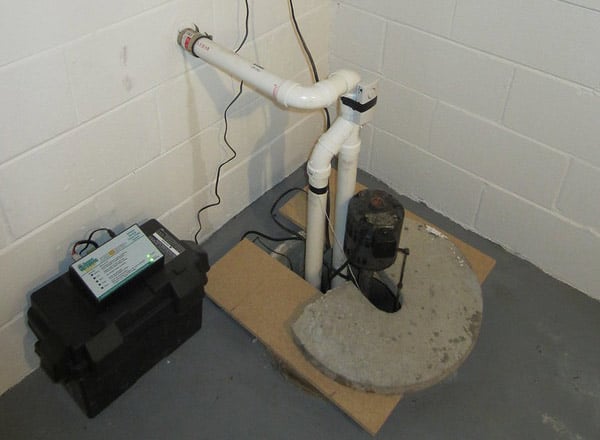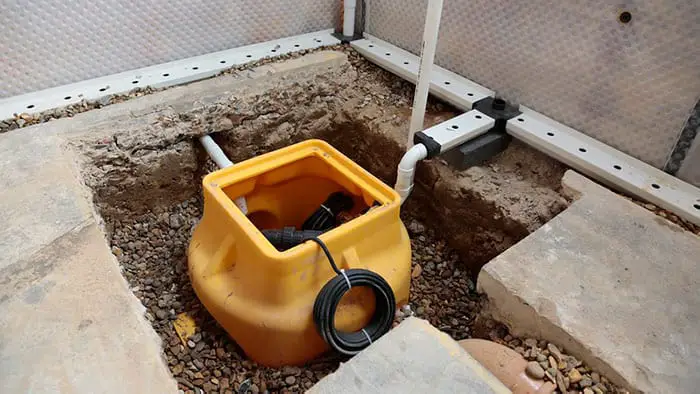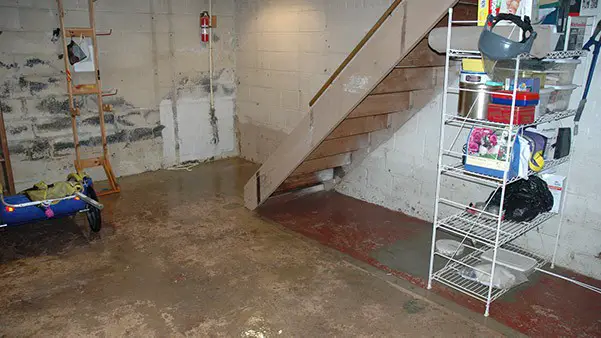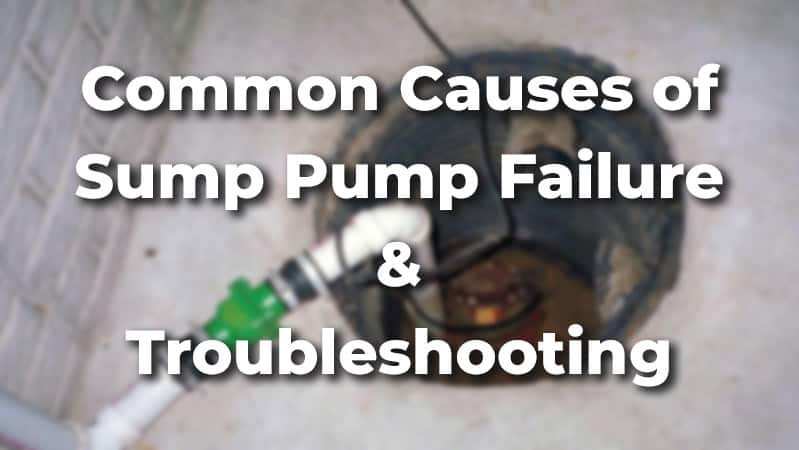Sump pumps provide an effective way to drain water from your house. They quickly eliminate excess water and prevent your basement from flooding that might occur after heavy rains, rapid melting of snow, or because of groundwater.
Sump pump failure is a pretty common issue, especially if maintenance is neglected. I know from experience.
There are many possible causes of sump pump problems, however, it’s not that difficult to find the reason behind a faulty device if you follow a step-by-step troubleshooting guide.
In the vast majority of cases, sump pump failure is caused by one of the issues I’m about to show you. Note that not all problems listed below can be solved DIY. Much depends on the cause of the failure. When in doubt, you can always reach out to the manufacturer or ask a plumbing expert.
Safety first: If your sump pump is not working properly in a flooded basement, the first thing you should do is shut off the electricity in that area. Do not enter a wet basement until the power has been disconnected because that could lead to an electric shock. Also, make sure you read the safety instructions of the manufacturer before troubleshooting.
Possible Causes of Sump Pump Failure
1. Switch Problem
One of the most common causes of a malfunctioning sump pump is a stuck or faulty switch. Most sump pumps turn on either through a pressure sensor or a float activator.
In the latter case, the float, which is responsible for switching on and off the pump, sometimes gets stuck and won’t change its position, even if the water level rises. Therefore, the float activator arm won’t turn the switch on and the pump stays off.
This scenario often occurs when a submersible pump, for some reason, shifts from its original position inside the sump basin.
The lack of proper maintenance can lead to debris accumulation in the basin that sometimes can prevent the free movement of the float, thus the smooth operation of the switch.
As a side note, we’ve created a useful guide about maintenance to help you extend the life of your sump pump and increase its reliability.
If your sump pump is running continuously and doesn’t turn off, there’s likely either a switch or a check valve problem.
If the cause of the switch failure is purely mechanical, the solution is often as easy as cleaning the basin and repositioning the sump pump so that the float can move freely.
Therefore, it’s often a good idea to start diagnosing the problem by checking the switch.
2. Overworked Sump Pump
Your sump pump can quickly become overworked in a bunch of different situations. In fact, overwhelming is a common reason for a faulty or broken sump pump. Let’s see the possible causes.
An excessive influx of water. In case of flooding or heavy rains, your sump pump might not be able to deal with the high amount of water, especially if it’s not powerful enough. Upgrading your sump pump or using more than one device can solve this issue.
The power of your sump pump is typically given in horsepowers. How much do you need? Well, it depends on many factors, such as the depth of your basement, the size of the sump pit, or the climate (do floods occur often?). Often it’s a good idea to consult with an expert who can help you with the calculation based on your individual needs.
Note that in some cases, you might need an extra pump to keep up with a high volume of water.
Small sump pit. Sometimes the sump pit is simply too small and that makes the pump turn on too often. An improperly sized sump pit is filled quickly with water and that constantly triggers the appliance that will empty the pit in no time. Turning on and off repeatedly within a short time makes the motor of the pump wear out quickly.
Stuck switch. As previously mentioned, if the float gets stuck, the device might never turn off (or on). It usually happens due to the shift of the device or debris accumulation.
Broken check valve. Usually, there’s a so-called check valve inside the discharge pipe that prevents the water from flowing back into the pit. If this valve is broken, a significant amount of water will flow back into the pit during the operation of the sump pump and that can easily overwhelm the device and may lead to a failure.
3. Pump Burn Out
An overworked pump can easily burn out if you won’t reduce the load. A sump pump typically turns on only when needed, however, in case of a failure or during floods or heavy rains it might be working constantly. If that is the case, chances are great that the pump will burn out sooner or later.
To avoid this situation, make sure your sump pump is powerful enough to handle the volume of water entering the pit. Also, check if the pump works only if there’s water in the sump pit.
If the sump basin is dry and the pump is still working, the float switch is likely to be stuck or faulty. If you notice that your sump pump is running dry, you should unplug it immediately.
If you live in an area where floods are common, you may want to know how you can effectively seal your doors to keep water out. We’ve collected the best methods in this article.
4. Power Outage

It may sound obvious, but one of the first things you should do when your sump pump stops working is to check the power supply. Blackouts happen, especially during heavy storms when you need your sump pump the most.
Sometimes the power failure is localized to only one specific part of your home. Therefore, it’s always a good idea to check if the socket that the appliance is plugged into is live.
If you want to make sure your sump pump won’t let you down even during a power outage, you can use a generator. This way your basement won’t be flooded even if a heavy storm causes a power failure. If storms are frequent in your region, a backup generator can really give you peace of mind.
As an alternative, you can install a battery-powered backup sump pump that will prevent your basement from flooding if the electricity goes out. Having a backup system is highly recommended.
5. Clogged or Frozen Discharge Pipe

A clogged or frozen discharge pipe is a common cause of sump pump failures. The discharge pipe runs from the sump pit to the exterior space where the water drains away. If this pipe is clogged, the system stops working and water accumulates in the basement.
Discharge pipes can be clogged with rocks, rodents, dirt, roots, etc. You should always keep your pipe clean, otherwise, your sump pump won’t be nearly as effective as it should be (or it won’t work at all).
You can prevent your pipe from clogging by protecting its opening with a grate or a screened vent cap.
In winter months, discharge pipes often freeze. This is a common issue and can be solved in many different ways.
First, identify exactly which part of the pipe is frozen. Often, the part that goes through the wall is the most prone to freezing. If this is the case, add insulation or use heat tape (you can also use some straws).
If your discharge line runs in the ground, make sure it’s deep enough (it should run below the frost line).
6. Clogged Sump Pump
If your sump pit isn’t covered with a lid, chances are great that dirt will quickly accumulate in it and clog your system. If you suspect that your sump pump is clogged, unplug the device and check the openings (you can use a flashlight to see clearly): if something is blocking the inlet, remove it.
Don’t forget to clean the sump basin too, because if you won’t eliminate the debris and silt, the pump will be clogged again sooner or later.
7. Failure Due to Old Age
Nothing lasts forever. Depending on the quality and age of your sump pump, as time goes on, the different parts (including the motor) of your appliance are worn out and stop working properly.
A plumbing expert sometimes can do wonders, however, if your sump pump is more than 10 years old, it’s likely that you’re better off replacing your old device with a new one.
8. Incorrect Installation (Or the Sump Pump Is the Wrong Size)
Proper installation is key to avoiding sump pump failures. Every device is different, therefore the manufacturer’s instructions should always be followed during installation.
In most cases, the discharge pipe should have a built-in check valve that prevents the water from flowing back into the sump pit. Most sump pump models need this valve to work properly.
Another common issue is that the sump pit is too dirty or has an improper size. That can cause the jam of the float switch or shorten the lifespan of the device.
Sometimes the source of the failure is that the sump pump is the wrong size.
If you have a device too small or too big for your home, you are much more likely to face failures. Therefore, you always want to make sure you have the right size sump pump installed.
Wondering what size sump pump you need? Check out the video below:
9. Dysfunctional Drainage System

A fully functioning and properly designed basement drainage system is essential if you want your sump pump to work effectively. It collects water and discharges it into the sump pit with the help of gravity.
If your drainage system is clogged, damaged, or poorly designed, water won’t be drained, even though the pump is working properly.
So, if your sump pump seems to be working fine, but there’s water in your basement, make sure you check your drainage system.
While there are many types of drainage systems, all of them work on the same principle: they help keep your foundation and basement dry by channeling water into a pit. Therefore, their maintenance is not complicated at all.
10. Lack of Maintenance
Proper maintenance can significantly extend the lifespan of your sump pump. Lack of maintenance does the exact opposite.
Make sure you regularly check the sump basin, the discharge pipe, the drainage system, and the device itself, and do some cleaning or adjusting when needed. Make sure you follow the manufacturer’s instructions. If you’re not a big fan of DIY, you can call a professional that will do the job for you.
If you have ignored maintenance recently, it’s likely that the cause of the failure is a clogged pipe or device or a jammed float switch.
11. Defective Sump Pump
While this is one of the least common causes of a sump pump failure, occasionally it might happen that a new sump pump is defective and fails immediately or shortly after installation.
You can easily test your appliance by pouring water into the sump pit and checking if it pumps the water out from the pit.
Common Signs of Sump Pump Problems
- The sump basin is filled with water but the pump doesn’t turn on.
- The performance of the pump is reduced and it removes water slowly.
- The pump is running non-stop or too often, even if the basin is empty.
- You can hear loud or strange noises while the system operates.
- The basin refills quickly.
Troubleshooting – What to Do If Your Sump Pump Is Not Working?
1. Check the Power Source
You can easily check if the socket of the sump pump is live by plugging another appliance into it. If you can turn that on, you can be sure that the pump is also getting power, so the cause of the failure is something else.
2. Make Sure the Float Switch Is Not Jammed
A stuck float switch is a very common problem. Usually, the float gets stuck when the device shifts from its original place in the sump basin or when there’s debris in the pit. So, as a second step, check out if the float can move freely.
3. Check the Discharge Pipe
If the discharge pipe is clogged or frozen, the pump will fail to remove water from your basement. Make sure there isn’t any dirt or ice in the pipe, and its opening isn’t blocked.
The discharge pipe should have a fully functional check valve that prevents water from flowing back to the pit. If that valve is broken, the pump is likely to be unable to remove the water from the pit, thus it will run constantly or too frequently.
Most discharge pipes also have an air relief hole (it’s pretty small) that can easily become clogged and lead to failure. Don’t miss checking it out when troubleshooting.
4. Check If the Sump Pump Is Clogged
The next step is to check whether the inlet of the device is blocked. If that happens, the pump can easily become overwhelmed in case of heavy rain because it can’t keep up with the high amount of water.
5. Make Sure Your Sump Pump Is the Right Size
Maybe your sump pump is working properly but it simply doesn’t have the right capacity. Perhaps you need more horsepower to keep your basement dry. If that is the case, you should consider getting a more powerful pump that suits your needs.
How to Prevent Sump Pump Failure

So what should you do to prevent the above-mentioned problems? Well, while it’s true that you can’t avoid all the issues if you use your appliance properly and don’t ignore maintenance, you can extend the lifespan of your sump pump and save yourself a lot of annoyance.
When it comes to maintenance, you should always follow the instructions of the manufacturer, however, there are some basic recommendations that will help you prevent failures in most cases:
- Remove debris, sand, and gravel from the sump pit regularly.
- Keep the drainage system clean and make sure it channels water into the pit properly.
- Make sure the discharge line isn’t clogged or frozen.
- Test your sump pump regularly: pour a few gallons of water slowly into the sump basin and check if the float switch elevates and the sump pump turns on. The pump should eliminate the water from the basin and turn itself off.
- Check if water doesn’t flow back into the pit: that could be a sign of a broken check valve.
As an additional safety measure, you can also install a sump pump failure alarm that will help you detect failures early. If your sump pump is not working and water starts to accumulate in the pit, the alarm will sound before your basement becomes flooded.
Some models are Wi-Fi enabled, so they can send you an alert to your phone if there’s a problem.
Related Questions
What is the most common cause of sump pump failure?
The most common causes are power outages, stuck switches, and clogged discharge pipes.
Does the homeowner’s insurance cover (water damage from) sump pump failure?
Well, it depends on the type of insurance you have. Unfortunately, most standard homeowners’ insurance won’t cover water damage due to a faulty sump pump. However, you can add coverage for sump pump failure anytime (not the same as flood coverage!).
What is the average cost to replace a sump pump?
According to HomeAdvisor, the average cost of replacement ranges from $800 to $2000 (submersible) and from $400 to $900 (pedestal). Of course, the replacement can be significantly cheaper if you do it yourself as a good quality new submersible sump pump usually costs less than $400.
What about repairing? Is it worth it?
It depends on the cause of the failure. Repair cost usually ranges from about $300-$750, so in some cases, you’re better off with a new device, especially if you can install it by yourself.
How long does a sump pump last?
Experts say that a sump pump has a lifespan of 10 years on average, however much depends on the build quality and frequency of use.
Photos: Flickr (Fairfax County, Scott Akerman, State Farm, Jeff Covey, BRE Group)












